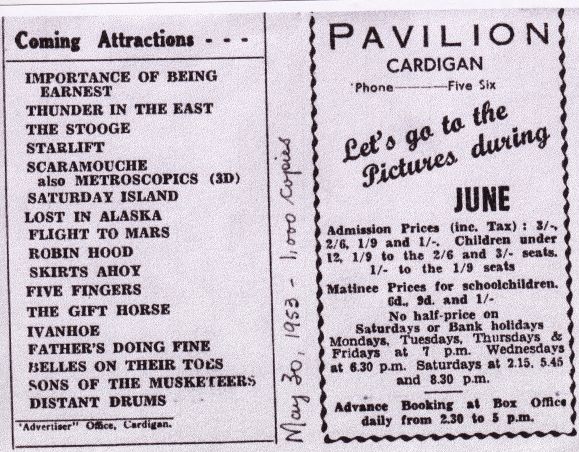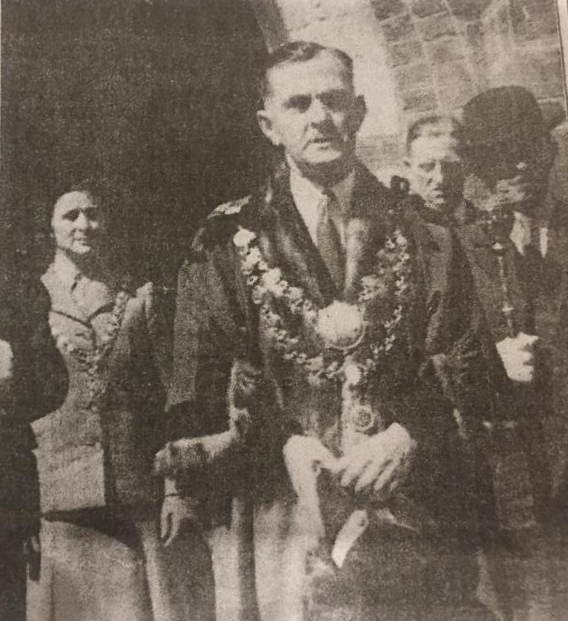Thanks to Keith Ladd





Clockwise:
1 The Market in its heyday in the 1880s
2 The Tivy-side reports on plans for a multi storey square block in the middle of town instead of the Guildhall (1960s).
3 The old Market Yard
4 Cardigan and Brioude Town Twinning Meeting with the mayor and mayoress Mr and Mrs Berwyn Williams, and the local MP Elystan Morgan.
5 The Guildhall as a Polling Station.
Thanks to Keith Ladd







Dr James Mathias Phillips M.D., M.R.C.S., L.S.A. (1839–1903)
Native of St Dogmaels. In 1870 he was surgeon to Morfa Colliery, Margam. Returned to Cardigan during the 1880s. Lived and worked from 10 Priory St. Mayor in 1882. By 1901 he was living in Bank House, 6 High St. Baptist, member at Blaenwaun, Buried at Blaenwaun. His son Llewellyn Caractacus Powell Phillips was also a doctor (see below).
Dr Llewellyn Caractacus Powell Phillips M.A., M.D., F.R.C.P., F.R.C.S. (1871–1927):
| This is what the British Medical Journal has to say about him: He was born at Taibach, Glam. on July 28th 1871. In 1881 he was living in 10 Priory St. From Epsom College he went to Caius College, Cambridge, in 1889, obtaining first-class honours in Part I of the Natural Science Tripos of 1892, and then entered as a student at St Bartholomew’s Hospital. He qualified as MRCS, LRCP, in 1894, took the MB and B.Ch Camb degrees, in 1895, and in 1897 obtained diploma of FRCS Eng. In 1903 he proceeded MD and obtained MRCP and in 1909 elected Fellow of the Royal College of Physicians of London. He practised for a while at Cardigan. (c.1898) His career in Egypt began when he was appointed resident surgical officer of the Kasr-el-Aini Hospital Cairo. Elected Professor of Medicine in the Royal School of Medicine, Cairo. During WW1 he held a temporary commission as lieutenant-colonel RAMC, and commanded the British Red Cross Hospital at Giza; he was mentioned four times in dispatches. From 1914 to 1917 he held the appointment of physician to H.H. la Hussein Kamel, Sultan of Egypt, and for his services was made a member of the Orders of the Nile and of the Medjidie. He made a remarkable collection of old Arab glass weights and coins, and died at his house in Cairo in January, 1927. He contributed articles on tropical medicine to various medical journals including: “Phlebotomus Fever” in Bryan and Archibald’s Practice of Medicine in the Tropics, v Amoebiasis and the Dysenteries, 8vo, London, 1915. There is a plaque in memory of this gentleman in St Mary’s Church: https://www.geograph.org.uk/photo/6273412 |
Saturday Night at the Black: Cardigan in the Swinging Sixties. 183pp. with over 100 illustrations, many of which you will not have seen before, by William H. Howells. Price £10. Printed by E. L. Jones, Aberteifi. ISBN 978 1 78280 7698
It’s a remarkable story! The background is the close connection between some of the town’s characters and those linked with the emerging Liverpool music scene at the time. People like the dramatist Alun Owen, who came to live in St Dogmael’s between 1963 and 1967; Allan Williams, the Beatles’ first manager; Bill Harry, founder and editor of the pioneering Mersey Beat newspaper; Bob Wooler, the Cavern’s famous DJ; and George Melly, who bought a summer house in Pen-y-bryn. This motley crew, with their partners, were warmly welcomed by Frank Aspinall, of the Black Lion, and with their help organised Liverpool bands to play in the Black.
The book contains a complete list of all the groups who played there between 1963 and 1973. At first they came from the Cavern – many via the Kaiserkeller and other Hamburg clubs. Do you remember the visit of Screaming Lord Sutch to Cardigan? What about Rory Storm and the Hurricanes; Ian and the Zodiacs; The Clayton Squares; Vince Earl and the Talismen; Freddie Starr and the Nightriders; Sony Webb and the Cascades; Derry Wilkie and the Pressmen; The Kirkbys; The Masterminds; The Chessmen and The Kinsleys and many more?
Later the groups came from South Wales: do you remember James Hogg, The Iveys; Haverson Apricot; Peter Shane and the Vikings – and let’s not forget local groups including Ricky and the Raiders and Strawberry Maize?
Every Saturday night over 200 teenagers flowed into the town from a wide area of Cardiganshire, Pembrokeshire and Carmarthenshire to dance, to listen to music and to enjoy.
But not everyone was happy with these developments. Parents warned their offsprings not to go near such a place, and the respectable town councillors were unhappy that the Black gave the town a bad image.
Cardigan has not seen anything like this before or since.
Read the truth about the connection of the Beatles with the local Eisteddfod!
Read about the close link between ‘A Hard Day’s Night’ and St Dogmael’s.
You’ll be surprised to read the candid memories of those who were a part of the scene.
Available in bookshops NOW £10.

A solicitor who was the senior partner of the firm of Messrs. Asa and Ivor Evans, solicitors, Green-street. He was a town councillor, and chosen mayor in 1875 and 1876. A Liberal in politics, and a member of the Baptist cause, he had held several important offices, not the least being that of solicitor to the Baptist Association, which office he held for many years. He also acted in the same capacity for the South Cardiganshire Calvinistic Methodist Association. In conjunction with a number of others, he was instrumental in doing away with Church rates in the locality, he having gone as far as to allow his goods to be sold by way of protest against them.
‘Cardigan have suffered a severe loss in the death of Ald. Evans, and it will be long ere a leader of equal acumen and experience will be found to fill his place’.
THE FUNERAL: He was buried on 5 April Thursday at Penybryn burying ground. The funeral cortege was an exceedingly large and imposing one—a large number of ministers, the Mayor of Cardigan (in his robes of office), attended by the Town Clerk, Borough Treasurer, Members of the Corporation, and the Macebearers, headed the procession, which included about forty vehicles, a large number of horsemen and pedestrians, and extended nearly half-a-mile.
The service in the house (Pen’ralltcadwgan) was conducted by the Rev. W. Evans, Cilgerran, before reaching Penybryn Baptist Chapel, where the service was held, and addresses were delivered by the Revs. Mr. Griffiths (Bethel), Mr. Davies (Tyrhos), Mr. Jenkins (Newport.), Mr. Thomas (Blaenffos), Wm. Jones (C.M., Cardigan), Mr. G. Hughes (Cardigan), Mr. T. Phillips (Verwig), and others. At the graveside Rev. John Williams (Bethania, Cardigan), and R. Price (Cilfowyr) officiated.
12 1897 (Gwe.) In a Council meeting Cllr. W. J. Williams was presented with a silver cradle as a gift on the birth of his daughter during his year of office as mayor – the first gift a town mayor had received since 1647 when Jacobus Phillips, Tregibby presented the maces.
3 1949 (Thurs.) Drama Festival with Ceredigion’s most famous drama groups. Y Pibydd yn y Maes, T. C. Murray; trans. by Nan Davies with Gwmni Aelwyd Aberystwyth; Y Ty ar y Rhos, Amy Parry-Williams with Cwmni Talybont; Adar o’r Unlliw, J. O. Francis with Gwmni Beulah (T. Tegryn Davies). Also two one act plays by St Mary’s Cymry’r Groes: The Other side of the wall, P. M. Bentley; and Uncle Joseph, J. B. Trenwith.
Compere T. Tegryn Davies. Stage organisers : Fred Lewis, Garfield Thomas, Lemuel Morgan.
President : Cllr. W. L. Davies, Pantyderi; Chairman Ald. Hubert M. Davies DL, Chairman of Ceredigion Education Committee.
Doors open at 6.30. Start at 7.00 prompt; 5/- a 3/6 reserved seats; 2/6
Tickets from Nance Jones, Welsh Stores, Phone 191 (in case there are any tickets left!)
Proceeds to Memorial Hall Committee: Cllr. Jenkin Richards JP, mayor, Treasurer Nance Jones; Sec.: J. H. Johns.